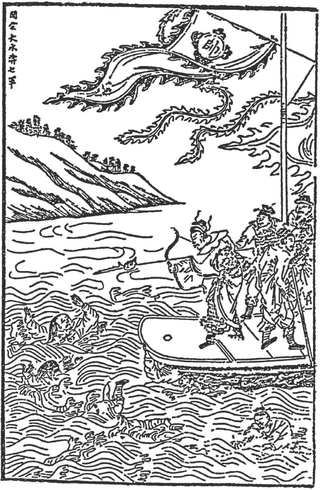
An ambush is a surprise attack carried out by people lying in wait in a concealed position. The concealed position itself or the concealed person(s) may also be called an "ambush". Ambushes as a basic fighting tactic of soldiers or of criminals have been used consistently throughout history, from ancient to modern warfare. The term "ambush" is also used in animal behavior studies, journalism, and marketing to describe methods of approach and strategy.

Xu Huang, courtesy name Gongming, was a Chinese military general serving under the warlord Cao Cao in the late Eastern Han dynasty of China. He later served in the state of Cao Wei during the Three Kingdoms period under the first two rulers, Cao Pi and Cao Rui, before his death at the start of Cao Rui's reign. Xu Huang is best noted for breaking the siege at the Battle of Fancheng in 219 by routing the enemy commander Guan Yu on the field.

The Battle of Fancheng or the Battle of Fan Castle was fought between the warlords Liu Bei and Cao Cao in 219 in the late Eastern Han dynasty. It is named after Fancheng in present-day Xiangyang, Hubei, a fortress that played a significant role in the battle.
The Ghaṭafān were an Arab tribal confederation originally based northeast of Medina. The main branches of the Ghatafan were the tribes of Banu Abs, Banu Dhubyan and Ashja'. They were one of the Arab tribes that interacted with Muhammad. They are notable for allying themselves with the Quraysh in the Battle of the Trench.

Lü Meng's invasion of Jing Province was fought between the warlords Sun Quan and Liu Bei in the winter of 219–220 in the late Eastern Han dynasty. Sun Quan's forces, led by Lü Meng, invaded Liu Bei's territories in southern Jing Province, which covered present-day Hubei and Hunan. The campaign occurred after the Battle of Fancheng and concluded with victory for Sun Quan's forces, who completely captured all of Liu Bei's territories. Guan Yu, Liu Bei's general guarding those territories, was captured and executed by Sun Quan's forces. The fall of Jing Province and Guan Yu's death provided the trigger for the Battle of Xiaoting between Liu Bei and Sun Quan between 221 and 222.
The Expedition of Qatan, was the first Raid on the Banu Asad bin Khuzaymah tribe, which occurred directly after the Battle of Hamra al-Asad in the year 4 A.H of the Islamic calendar.
The early Muslim–Meccan conflict refer to a series of raids in which the Islamic prophet Muhammad and his companions participated. The raids were generally offensive and carried out to gather intelligence or seize back the confiscated Muslim trade goods of caravans financed by the Mushrik of the Quraysh. His followers were also impoverished. The raids were intended to harm the economy and in turn the offensive capabilities of Mecca by Muhammad. The Muslims felt that the raids were justified in that the items being sold in the caravans were their own items, stolen by the Meccans when they had migrated to Medina.
The raid on Amarr, also known as the Raid on Ghatafan, occurred directly after the Invasion of Sawiq in the year A.H. 3 of the Islamic calendar, March 625. The expedition was ordered by Muhammad after he received intelligence that the Banu Muharib and Banu Thalabah tribes were planning to raid the outskirts of Madinah. Therefore, Muhammad launched a pre-emptive strike with 450 men.
Saʿd ibn Muʿādh al-Ansari was the chief of the Aws tribe in Medina and one of the prominent companions of the Islamic prophet Muhammad. He died shortly after the Battle of the Trench.
The Expedition of Abdullah ibn Unais, also known as the Assassination of Khaled bin Sufyan was the first attack against the Banu Lahyan, which took place in the month of Muharram in the year A.H. 3. It was reported that Khaled bin Sufyan Al-Hathali, considered an attack on Madinah and that he was inciting the people on Nakhla or Uranah to fight Muslims. So Muhammad sent Abdullah ibn Unais to assassinate him. After cutting off Khaled bin Sufyan's head at night, Unais brought it back to Muhammad.
The Expedition of al Raji occurred directly after the Battle of Uhud in the year AH 4 of the Islamic calendar.

The siege of Banu Qurayza took place in Dhul Qa‘dah during January of 627 CE and followed on from the Battle of the Trench.
The Invasion of Banu Lahyan took place in September, 627 AD in Rabi' al-awwal or Jumada Al-Awwal, 6 AH of the Islamic calendar.
Third Raid on Banu Thalabah took place in September, 627AD, 6th month of 6AH of the Islamic calendar
Expedition of Fadak, also spelt Fidak, took place in December, 627AD, 6AH, 8th month of the Islamic Calendar
Expedition of Abu Qatadah ibn Rab'i al-Ansari, to Batn Edam took place in November 629 AD, 8AH, 8th month, of the Islamic Calendar
The Expedition of Qutbah ibn Amir, against the Khath'am tribe, took place in August 630 AD, 9AH, 2nd month, of the Islamic Calendar.
This is a timeline of the early history of Islam during the lifetime of Muhammad. The information provided in this article is based on Islamic oral tradition, not on historical or archaeological evidence. A separate list of military expeditions and battles is at List of expeditions of Muhammad.
Banu Lahyan were an Arab pagan tribe during the time of Muhammad and were involved in several military conflicts with him. The first was in 625 during the Expedition of Abdullah Ibn Unais, where Muhammad sent Abdullah ibn Unais to kill Khaled bin Sufyan Al-Hathali, who was the chief of the tribe. Muhammad alleged that he was planning to attack Madinah and incite the people of Nakhla and Uranah to attack him. Therefore, he sent Abdullah ibn Unais to assassinate him in 625 during the Expedition of Abdullah Ibn Unais. This was followed by the Invasion of Banu Lahyan in September 627 when Muhammad ordered his followers to attack the Banu Lahyan tribe to get revenge for the killing of 10 Muslims in the Expedition of Al Raji
Batn Gharran was a location in Saudi Arabia during the Islamic Prophet Muhammad's era. Muhammad ordered the Invasion of Banu Lahyan which took place here. Muhammad set out in Rabi‘ Al-Awwal or Jumada Al-Ula in the year six Hijri with 200 Muslim fighters and made a feint of heading for Syria, then soon changed route towards Batn Gharran, the scene of where 10 Muslims were killed in the Expedition of Al Raji.





